A friend of mine would always say that living is the most beautiful thing if not for sicknesses. He wasn’t in any way suicidal. However, he was plagued by occasional brief illnesses that warranted him to visit his doctor. He saw his doctor for medical conditions as common as catarrh. By the time I introduced him to collarbone pressure points, he saw his doctor less and enjoyed life better.
The collarbone or clavicle is the fairly solid, S-shaped bone that joins the breastbone to the shoulder. Around this bone, there are pressure points that when stimulated bring instant relief to common bodily discomforts like pain, cough, headaches, and sore throat. Knowing these pressure points will not only save you a trip to the doctor but also give you better control of your body.
So, in this article, I’ll be sharing with you the pressure points in, near, and above the collarbone that will help you stay well and whole.
Why Does the Pressure Point In My Collarbone Not Work?

Acupressure and acupuncture therapy, which is quite distinct from physical therapy, has proved to be effective over the years. The way acupuncture and acupressure work is by unblocking the Qi, which is the vital energy of the body. Thus, both therapies, when used for medical care, stimulate the nervous system to promote energy flow, the flow of blood, and normal activities of the entire body.
However, you have to stimulate the right pressure points for your condition for acupuncture treatment to be effective. Therefore, the pressure point in the collarbone will not work when you’re stimulating it for a different ailment other than the ones it works for.
There is scientific evidence that pressure points under the collarbone are effective for cough-variant asthma. A clinical trial on 11 randomized studies involving 929 patients revealed that acupuncture is effective in relieving the symptoms of cough, phlegm, and diaphragmatic congestion.
Another reason why the pressure point in the collarbone is not working is the way you perform acupressure therapy on yourself. To effectively stimulate the collarbone acupoints, relax, apply firm pressure on the acupoints either in a circular motion or vertical movement for up to 3 minutes, then repeat the motion till you feel relief.
The Pressure Points For Cough and Sore Throat
Acupoint: Ren-22 (Other Names: The Conception Vessel-22/Tian Tu/Heaven Projection)
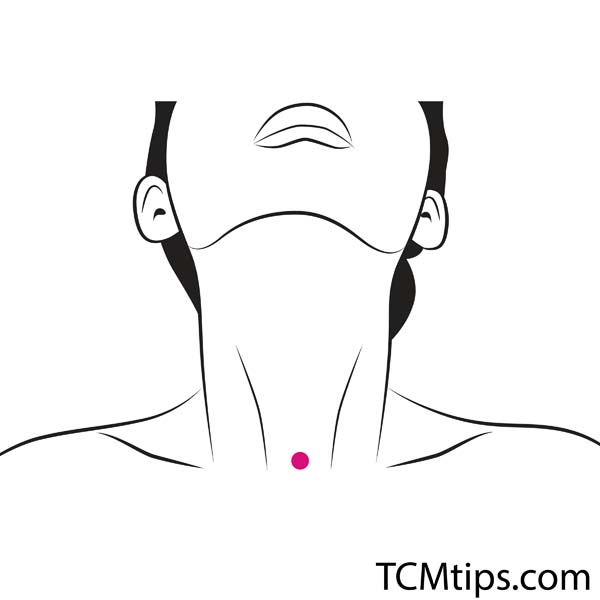
Ren-22 is the first collarbone pressure point on the list. It is called Tiantu in Chinese, which translates to celestial prominence. You’ll find Ren-22 in the central depression that joins the left and right collarbones.
In Traditional Chinese Medicine (TCM), Tiantu is responsible for subduing stubborn lung Qi, resolving phlegm, and stopping cough. It is for this reason that TCM healthcare providers use Ren-22 to treat cough, chest pain, and asthma. It is also one of the acupressure points for sleep apnea.
So, to activate the healing benefits of Tiantu, locate the acupoint and apply gentle pressure on it for 3 seconds. Do this two times at a time, and ensure not to push too hard as the throat is delicate.
Acupoint: LU-1 (Other Names: Lung-1/Zhong Fu/Middle Palace)
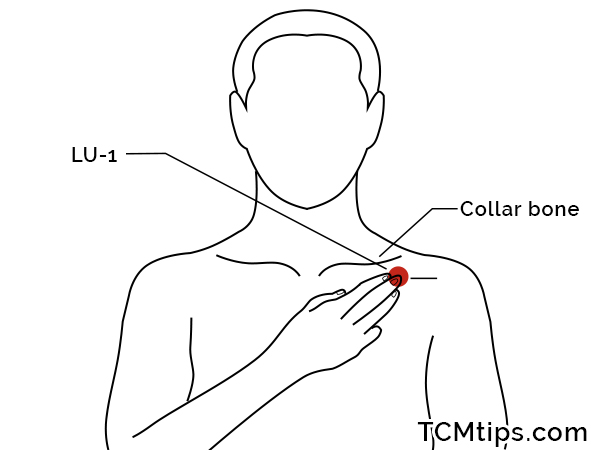
Lung 1 is the next acupoint for the collarbone. Also known as Zhongfu in Chinese, LU-1 is one of the pressure points under the collar bone. It is located between the first and second rib, in the first intercostal space, about seven finger-width from the midline of the chest, at a point where the shoulder muscle and the chest connects.
Lung 1 functions as a dispeller of heat and a stopper of cough. This is why it is effective in the treatment of cough while still serving as one of the acupressure points for chest pain, back pain, and asthma. However, you’ll have to be careful when pushing this acupoint as the muscles around it is thin.
Acupoint: ST-13 (Other Names: Stomach-13/Qi Hu/Door of Breath)
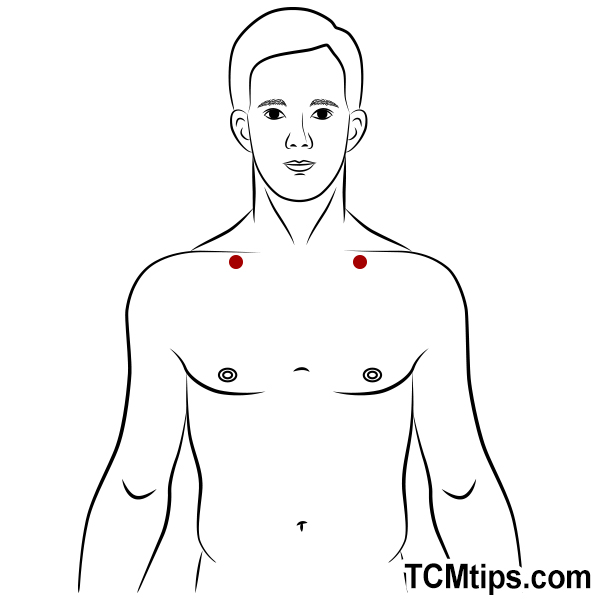
St-13, Qihu, or Qi door is another of the collarbone acupoints to push when you have a cough or sore throat. It is located at the lower edge of the middle of the collarbone, about five finger-width from the midline of the chest.
ST-13 is effective in treating cough, asthma, and congestion in the chest. However, you need to pay attention to massaging this acupoint to unlock its healing benefits. To stimulate ST-13, place your index and middle finger on the acupoint and push slowly for 10 seconds. Do this three times while exhaling and inhaling.
If you slide your palm from your chest to your neck while stimulating ST-13, it can help stiff shoulders or heavy chest.
The Pressure Point For Shoulder Pain And Headache
Acupoint: ST-12 (Other Names: Stomach-12/Que Pen/Empty Basin)
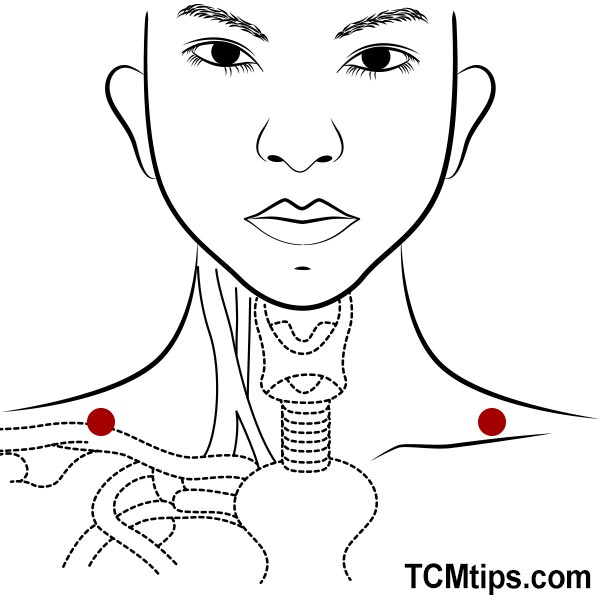
When it comes to shoulder pain and headaches, one of the collarbone acupoints to stimulate is ST-13. While ST-13 is at the border of the midpoint of the collarbone, ST-12 is located at the midpoint of the groove above the collarbone.
In TCM, ST-12 is regarded as the acupoint that promotes the flow of the lymph to the face and neck. Thus, when stimulated, your complexion is improved. Meanwhile, in addition to reducing headaches, ST-12 is also used for treating sore throat and asthma.
All you have to do to activate this acupoint is press down slowly on the acupoint in a circular motion with your index and middle finger for 30 seconds. Do this three times.
The Pressure Point For Boosting Immunity
Acupoint: KD-27 (Other Names: Kidney-27/Shu Fu/Shu Mansion)
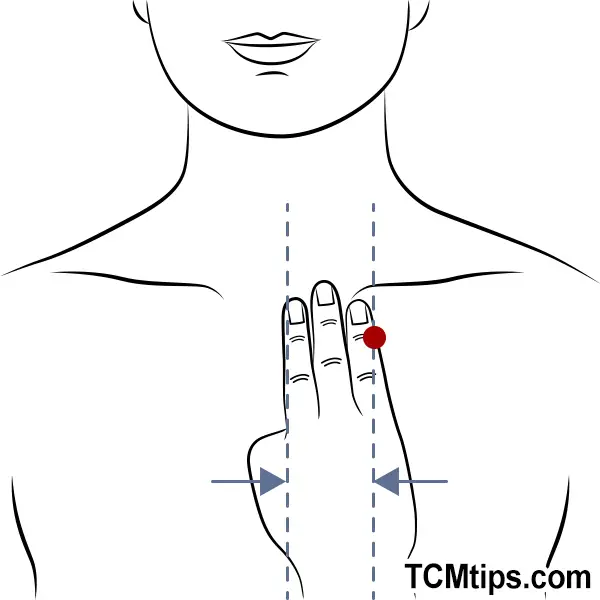
This is the pressure point under the collar bone for everyday bodily challenges that you need to know. KD-27, or Shufu as it is called in Chinese, is located at the lower edge of the collar bone, three finger-width from the midline of the chest.
In TCM, Shufu is responsible for boosting immunity, improving appetite, stopping cough, and reducing tension. It also helps in stopping vomiting.
However, to enjoy these benefits of Shufu, locate the acupoint and then use your index, middle, and ring finger to press gently and slowly on the acupoint. Do this for 3 seconds while exhaling, relax a bit, then continue again for 3 to 5 seconds until you start to feel pain.

Try our Anti-Aging Gua Sha Tool designed to bring out your skin’s natural glow.
Best Gua Sha Product- Anti-Aging: The tool is designed to target 11 specific aging signs such as wrinkles and sagging skin. By following the 7-step routine, users can improve skin firmness and reduce fine lines naturally.
- Enhances Skincare Routine: It works effectively with serums and lotions, boosting absorption and efficacy of skincare products.
- Visible Skin Improvement: Users can expect a smoother complexion, reduced puffiness, and a more youthful appearance.
 P. Sze
P. Sze 
















